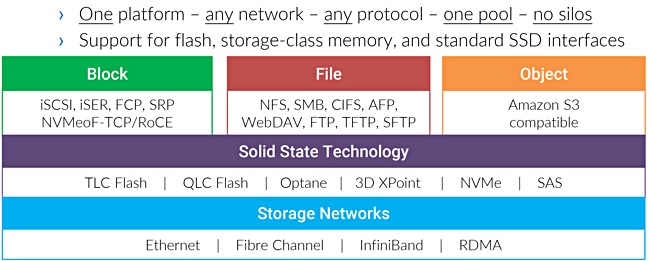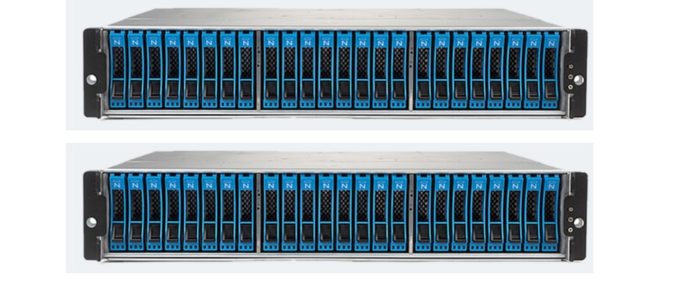Update: May 18 – TouchSupport customer review of ExaFlash One.
Nimbus Data, a data storage vendor based in Los Angeles, has announced the ExaFlash One all-flash array with a multi-function, multi-protocol, multi-mode OS, and simplified and transparent pricing.
The company has recruited Eric Burgener, research VP in IDC’s Infrastructure Systems, Platforms and Technologies Group, for this quote: “With its versatility, federated architecture, and multi-tenant management capabilities, Nimbus Data AFX is a well-conceived solid state storage platform for dense enterprise workload consolidation.”
A customer, Nick Smith, director of Remote IT and Broadcast Engineering at World Wrestling Entertainment, said: “We were able to deploy it in 30 minutes. We are consistently writing to the ExaFlash array at line-rate, and it is performing flawlessly.”
The array hardware is a 2U x 24 x U.2 slot enclosure with dual active:active controllers.

Supported host links are 8 x 16Gbit/s FC, 8x 10 or 40GbitE, 8 x InfiniBand FDR, or 4 x 16Gbit/s FC + 4 x 10GbitE. A maximum 2 million IOPS of performance is claimed.
The case is populated with 48TB (12 x 4TB SSDs) to 768 TB (24 x 32TB SSDs) or delivered empty with a set of qualified 12Gbit/s SAS SSDs from Kioxia, Samsung, Seagate and Western Digital that customers can buy themselves.
The arrays can be federated but there is no back-end fabric, and no data IO between or across the federated systems. This is not clustering – the federation is via scale-out independent nodes.
ExaFlash One has a separate out-of-band Ethernet management link with a single and central point of management.
AFX software
The AFX operating system is claimed to provide block, file and object storage (S3) access with a wide set of supported access protocols:

It is also said to include data management features including snapshots, cloning, replication, multi-pathing, RAID, thin provisioning, compression, deduplication, checksums and encryption.
The array can be operated in three modes;
- Intelligent mode – with the data management features
- Ludicrous mode – RAID protection only and optimised for throughput and IOPS
- Bare-metal mode – with direct access to each SSD using NVMe-oF, iSCSI. FC or SRP
Support and pricing
Nimbus has announced a support scheme with a flat annual fee per array and a single support tier with 24 x 7 x 365 availability and next-day parts replacement. There are free non-disruptive controller upgrades after three years, all-inclusive software, free software updates and an absence of capacity-based license fees.
The company said the array’s power usage is carbon-neutral, courtesy of a renewable energy offset scheme. There is a 60-day money-back guarantee and support contracts run from one to seven years.
Customers can set up an account on the Nimbus website, spec out and price an array themselves. Nimbus claims a $10,000 starting price but we were only able to get down to $20,000 using the online facility.
Update: That was by selecting the ‘No SSDs included’ option. Nimbus explains that $10,000 is the ExaFlash One system base price, including all software, and Tectonic is $10,000 per year.

Choosing the maximum capacity system of 768TB would cost $212,000.
TouchSupport customer view
Touch Support CTO Jason Hamilton was quoted in Nimbus’ announcement; “We chose ExaFlash One for our internal VMware environment and have been very pleased with its speed, availability, and ease of use. Given our experience, we recommend ExaFlash to our clients for their critical workloads.”
Touch Support is based in Chicago. We contacted Jason and asked him three questions about his decision to buy the ExaFlash One array.
Blocks & Files: Could you tell me what were the alternative arrays you considered for your workload and why you chose the ExaFlash ONE?
Jason Hamilton: When we started research for a new SAN I cast a wide net but ultimately narrowed our options down to three choices. HPE Nimble all-flash, Fujitsu (ETERNUS AF250 S2) and of course Nimbus ExaFlash.
There were a couple of reasons that we chose Nimbus. Firstly and probably most was price. Nimbus is priced very competitively even factoring in a 5-year support contract paid upfront.
Next, it’s important to know that I’ve been following Nimbus since mid-2012 where I learned of the company and their S-series arrays at a VMware conference. Even back then they were producing all-flash arrays touting 1 million IOPS. This impressed me greatly and I kept an eye on their progress over the years.
The Fujitsu option is very much a new player in the segment and didn’t give me as much confidence in their ability to maintain the product considering their diversified nature.
Lastly, going with ExaFlash seemed to make the most sense. This is their most recent flagship platform and would stand to have the longest support-life period available. We generally try to maximize our hardware lifecycle and it is critical to maintain an active support contract on critical systems such as a SAN.
Blocks & Files: How are you using the array? I mean for block, file or object work?
Jason Hamilton: We are an all VMware shop so the array is configured only for iSCSI block access to our ESXi hosts. We naturally do use the compression and deduplication features at the array level as well.
Blocks & Files: How does it compare to other arrays you have had experience with?
Jason Hamilton: Having either closely worked with or at the very least run proof-of-concept on a number of SAN and NAS solutions, the Nimbus ExaFlash is refreshingly simple. Coming from a Unix/Linux background the option to handle all configurations completely from an ssh shell is very pleasing. The web-based interface is likewise very simple to use and doesn’t have any irksome custom plugin requirements. Gone are the days of separate fat-client software or the hit-or-miss vSphere plugins for management and configuration.
Background
Nimbus has sold ExaFlash arrays since 2016 and claimed 200 customers in 2018. It now says it has 600 deployments. CEO and founder Thomas Isakovich says Nimbus was profitable in 2019 and expects to grow profits this year.
The privately-owned company appears to be very small. Six employees are listed for Nimbus Data on LinkedIn and the leadership page on its website lists one executive officer – Isakovich.








